January 29, 2004
For those of you following this web site, you should know that the daily contributions and photographs are part of group effort. As with most things at sea, collaboration and cooperation are key to getting things done well, safely and hopefully in everyone's best interest.
Yesterday's update was written by Ian Ridley. Today's is written by John Maclennan a geochemist/geophysicist from the University of Edinburgh in Scotland. This is John's first oceanographic cruise.
We continue to steam south-southeast at about 12 knots in calm seas. The ship's crew has made us feel extremely welcome and the ship's equipment is in excellent shape. The Alvin Group is servicing the penetrators (the devices that permit electrical wires to pass through the hull from the outside to the inside of Alvin's sphere and withstand the pressure in the deep ocean. They are also servicing the plastic viewports and the seals around them. This is the kind of routine maintenance that has to be done in order for the submersible to be in top shape, operate safely and ready to do deep sea science.
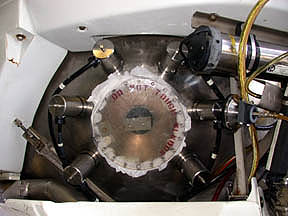 The starboard viewport in Alvin with the viewport removed. The penetrators
are the large metal cylinders arranged around the viewport.
The starboard viewport in Alvin with the viewport removed. The penetrators
are the large metal cylinders arranged around the viewport.
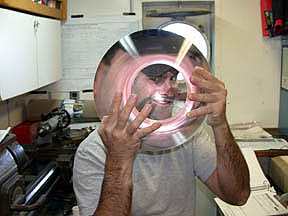 Bruce Strickrott,
one the Alvin pilots, holds up the viewport that is being serviced in
the Mechanical Shop. It is made out of a special plexiglass, and its geometric
shape is a frustum - a cone with the pointy end cut off, forming a plane
that is parallel to the base of the cone. The viewport is about 9 inches
thick.
Bruce Strickrott,
one the Alvin pilots, holds up the viewport that is being serviced in
the Mechanical Shop. It is made out of a special plexiglass, and its geometric
shape is a frustum - a cone with the pointy end cut off, forming a plane
that is parallel to the base of the cone. The viewport is about 9 inches
thick.
We awoke this morning after a night of peaceful sleep and gentle rocking by the Pacific. The ocean is blissfully calm, giving us a chance to plug in our sea legs. If such conditions persist then Javier might get rid of his medicinal aft-ear patch. The computers were sorted out by the expert shipboard techs, Dave Sims and Robbie Laird, just after breakfast and everybody was soon enjoying email and the network.
Scientists
working
in the Main Lab. 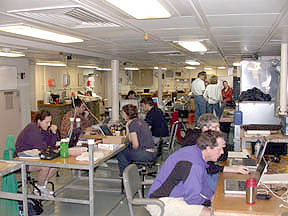
A misunderstanding between northern British accents led a great surplus of Italian coffee being produced at the 'Barista' station in the Main Lab. But the confusion and spillage were soon cleared up. Next, Adam Soule demonstrated the usefulness of the Geographic Information System (GIS) database he has compiled for the East Pacific Rise for our science and dive planning. He has linked over sixty thousand digital images of 6m by 4m patches of the seafloor to high resolution bathymetry maps and sidescan sonar images. Over the next few days, we will be shown how to navigate around this system, performing virtual Alvin dives. The goal of this exercise is to relate features from maps to the photographs and at the same time learn how to identify lava morphology in a consistent manner.
The task of calibrating the speech recognition software to be used in Alvin to record notes during each dive has fallen to Clare Williams and Vicki Ferrini. Much of the calibration consists of repeating ‘eh?’ and telling stories about famous American comedians. It is not yet clear if the software is ready to translate the sounds of the R/V Atlantis' ice-maker, situated directly behind Clare in the Main Lab.
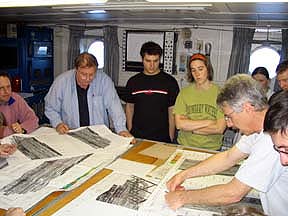 The
science party discussing the high resolution sonar and bathymetric data
in the Computer Lab this afternoon.
The
science party discussing the high resolution sonar and bathymetric data
in the Computer Lab this afternoon.
After lunch we met for an introduction to some of the key scientific issues that we hope to address on this cruise. Hans Schouten and Dan Fornari led us on a tour of a sidescan images of some of the potential dive sites, pointing out faults, fissures, channels and mounds with experts’ eyes. The dive site is certainly full of rocky delight and eastern Pacific promise. Next, Dan took us out into the afternoon sun to inspect his latest deep sea towed camera system, AKA the 'Rabbit-Cam'. The beauty of this particular system is that rock samples can be acquired simultaneously with the sea-floor photos, and this ability will allow us to relate the geochemical compositions of lava rocks to the flow features. The purpose of the large quantities of fishing line and surf wax in the rock handling room has now, thankfully, become clear... I’m sure that I’ll sleep sounder tonight with that knowledge in place.
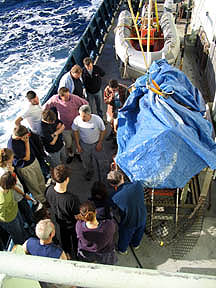 Dan Fornari describing the operations and characteristics of the Woods
Hole Oceanographic Towed Camera System (AKA Rabbit Cam) to the scientific
party by the starboard rail of R/V Atlantis.
Dan Fornari describing the operations and characteristics of the Woods
Hole Oceanographic Towed Camera System (AKA Rabbit Cam) to the scientific
party by the starboard rail of R/V Atlantis.
Tonight, Bill Seyfreid, from the Univ. of Minnesota, is going to deliver an after dinner seminar on the the in-situ chemistry of hydrothermal vents and the nature of his experiments that he will carry out during 4 Alvin dives on this cruise.